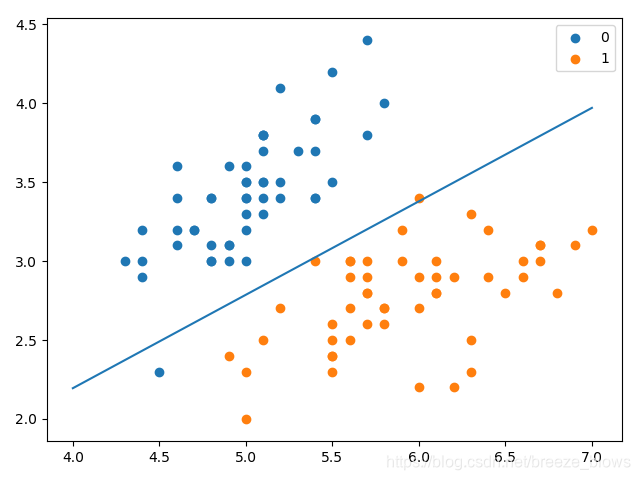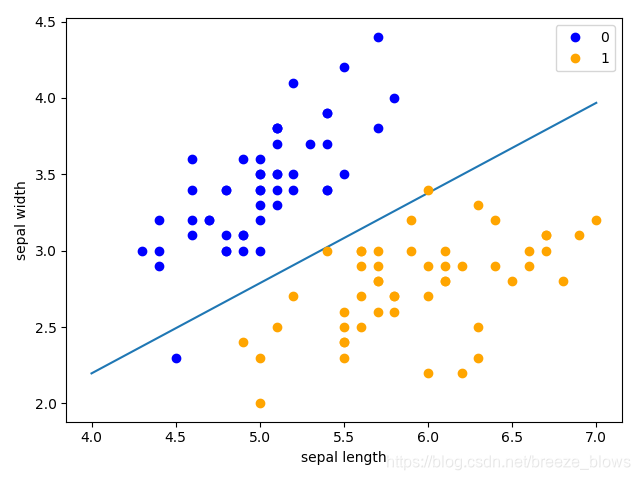| =============================== 【回到目录】=============================== |
|---|
第6章 逻辑斯谛回归(LogisticRegression)代码实现
LogisticRegression
from math import exp
import numpy as np
import pandas as pd
import matplotlib.pyplot as plt
from sklearn.datasets import load_iris
from sklearn.model_selection import train_test_split
# data
def create_data():
iris = load_iris()
X, y = np.array(iris.data), np.array(iris.target)
return X[:100, 0:2], y[:100]
X, y = create_data()
X_train, X_test, y_train, y_test = train_test_split(X, y, test_size=0.3)
class LogisticRegressionClassifier:
def __init__(self, max_iter=200, learning_rate=0.01):
self.max_iter = max_iter
self.learning_rate = learning_rate
def sigmoid(self, x):
return 1 / (1 + exp(-x))
def data_matrix(self, X):
data_mat = []
for d in X:
data_mat.append([1.0, *d])
return data_mat
def fit(self, X, y):
# label = np.mat(y)
data_mat = self.data_matrix(X) # m*n
self.weights = np.zeros((len(data_mat[0]), 1), dtype=np.float32)
for iter_ in range(self.max_iter):
for i in range(len(X)):
result = self.sigmoid(np.dot(data_mat[i], self.weights))
error = y[i] - result
self.weights += self.learning_rate * error * np.transpose([data_mat[i]]) #注意这里的[data_mat[i]]
print('LogisticRegression Model(learning_rate={},max_iter={})'.format(self.learning_rate, self.max_iter))
# def f(self, x):
# return -(self.weights[0] + self.weights[1] * x) / self.weights[2]
def score(self, X_test, y_test):
right = 0
X_test = self.data_matrix(X_test)
for x, y in zip(X_test, y_test):
result = np.dot(x, self.weights)
if (result > 0 and y == 1) or (result < 0 and y == 0):
right += 1
return right / len(X_test)
lr_clf = LogisticRegressionClassifier()
lr_clf.fit(X_train, y_train)
lr_clf.score(X_test, y_test)
x_ponits = np.arange(4, 8)
y_ = -(lr_clf.weights[1]*x_ponits + lr_clf.weights[0])/lr_clf.weights[2]
plt.plot(x_ponits, y_)
#lr_clf.show_graph()
plt.scatter(X[:50,0],X[:50,1], label='0')
plt.scatter(X[50:,0],X[50:,1], label='1')
plt.legend()
plt.show()
output:

最大熵模型 IIS
import math
from copy import deepcopy
class MaxEntropy:
def __init__(self, EPS=0.005):
self._samples = []
self._Y = set() # 标签集合,相当去去重后的y
self._numXY = {} # key为(x,y),value为出现次数
self._N = 0 # 样本数
self._Ep_ = [] # 样本分布的特征期望值
self._xyID = {} # key记录(x,y),value记录id号
self._n = 0 # 特征键值(x,y)的个数
self._C = 0 # 最大特征数
self._IDxy = {} # key为(x,y),value为对应的id号
self._w = []
self._EPS = EPS # 收敛条件
self._lastw = [] # 上一次w参数值
def loadData(self, dataset):
self._samples = deepcopy(dataset)
for items in self._samples:
y = items[0]
X = items[1:]
self._Y.add(y) # 集合中y若已存在则会自动忽略
for x in X:
if (x, y) in self._numXY:
self._numXY[(x, y)] += 1
else:
self._numXY[(x, y)] = 1
self._N = len(self._samples)
self._n = len(self._numXY)
self._C = max([len(sample)-1 for sample in self._samples])
self._w = [0]*self._n
self._lastw = self._w[:]
self._Ep_ = [0] * self._n
for i, xy in enumerate(self._numXY): # 计算特征函数fi关于经验分布的期望
self._Ep_[i] = self._numXY[xy]/self._N
self._xyID[xy] = i
self._IDxy[i] = xy
def _Zx(self, X): # 计算每个Z(x)值
zx = 0
for y in self._Y:
ss = 0
for x in X:
if (x, y) in self._numXY:
ss += self._w[self._xyID[(x, y)]]
zx += math.exp(ss)
return zx
def _model_pyx(self, y, X): # 计算每个P(y|x)
zx = self._Zx(X)
ss = 0
for x in X:
if (x, y) in self._numXY:
ss += self._w[self._xyID[(x, y)]]
pyx = math.exp(ss)/zx
return pyx
def _model_ep(self, index): # 计算特征函数fi关于模型的期望
x, y = self._IDxy[index]
ep = 0
for sample in self._samples:
if x not in sample:
continue
pyx = self._model_pyx(y, sample)
ep += pyx/self._N
return ep
def _convergence(self): # 判断是否全部收敛
for last, now in zip(self._lastw, self._w):
if abs(last - now) >= self._EPS:
return False
return True
def predict(self, X): # 计算预测概率
Z = self._Zx(X)
result = {}
for y in self._Y:
ss = 0
for x in X:
if (x, y) in self._numXY:
ss += self._w[self._xyID[(x, y)]]
pyx = math.exp(ss)/Z
result[y] = pyx
#或者写
# for y in self._Y:
# result[y] = self._model_pyx(y, X)
return result
def train(self, maxiter=1000): # 训练数据
for loop in range(maxiter): # 最大训练次数
print("iter:%d" % loop)
self._lastw = self._w[:]
for i in range(self._n):
ep = self._model_ep(i) # 计算第i个特征的模型期望
self._w[i] += math.log(self._Ep_[i]/ep)/self._C # 更新参数
print("w:", self._w)
if self._convergence(): # 判断是否收敛
break
dataset = [['no', 'sunny', 'hot', 'high', 'FALSE'],
['no', 'sunny', 'hot', 'high', 'TRUE'],
['yes', 'overcast', 'hot', 'high', 'FALSE'],
['yes', 'rainy', 'mild', 'high', 'FALSE'],
['yes', 'rainy', 'cool', 'normal', 'FALSE'],
['no', 'rainy', 'cool', 'normal', 'TRUE'],
['yes', 'overcast', 'cool', 'normal', 'TRUE'],
['no', 'sunny', 'mild', 'high', 'FALSE'],
['yes', 'sunny', 'cool', 'normal', 'FALSE'],
['yes', 'rainy', 'mild', 'normal', 'FALSE'],
['yes', 'sunny', 'mild', 'normal', 'TRUE'],
['yes', 'overcast', 'mild', 'high', 'TRUE'],
['yes', 'overcast', 'hot', 'normal', 'FALSE'],
['no', 'rainy', 'mild', 'high', 'TRUE']]
maxent = MaxEntropy()
x = ['overcast', 'mild', 'high', 'FALSE']
maxent.loadData(dataset)
maxent.train()
print('predict:', maxent.predict(x))
output:
predict: {'no': 2.8765395547617257e-06, 'yes': 0.9999971234604452}
sklearn LogisticRegression
import matplotlib.pyplot as plt
from sklearn.linear_model import LogisticRegression
clf = LogisticRegression(max_iter=200)
clf.fit(X_train, y_train)
clf.score(X_test, y_test)
print(clf.coef_, clf.intercept_)
x_ponits = np.arange(4, 8)
y_ = -(clf.coef_[0][0]*x_ponits + clf.intercept_)/clf.coef_[0][1]
plt.plot(x_ponits, y_)
plt.plot(X[:50, 0], X[:50, 1], 'bo', color='blue', label='0')
plt.plot(X[50:, 0], X[50:, 1], 'bo', color='orange', label='1')
plt.xlabel('sepal length')
plt.ylabel('sepal width')
plt.legend()
plt.show()
output:








 本文深入探讨了逻辑回归算法的原理及其实现过程,通过使用Python的sklearn库和从零开始编写代码两种方式,详细解释了逻辑回归在鸢尾花数据集上的应用。同时,文章对比了自定义逻辑回归模型与sklearn内置模型的性能,展示了模型的训练、预测及评估过程。
本文深入探讨了逻辑回归算法的原理及其实现过程,通过使用Python的sklearn库和从零开始编写代码两种方式,详细解释了逻辑回归在鸢尾花数据集上的应用。同时,文章对比了自定义逻辑回归模型与sklearn内置模型的性能,展示了模型的训练、预测及评估过程。
















 789
789

 被折叠的 条评论
为什么被折叠?
被折叠的 条评论
为什么被折叠?








